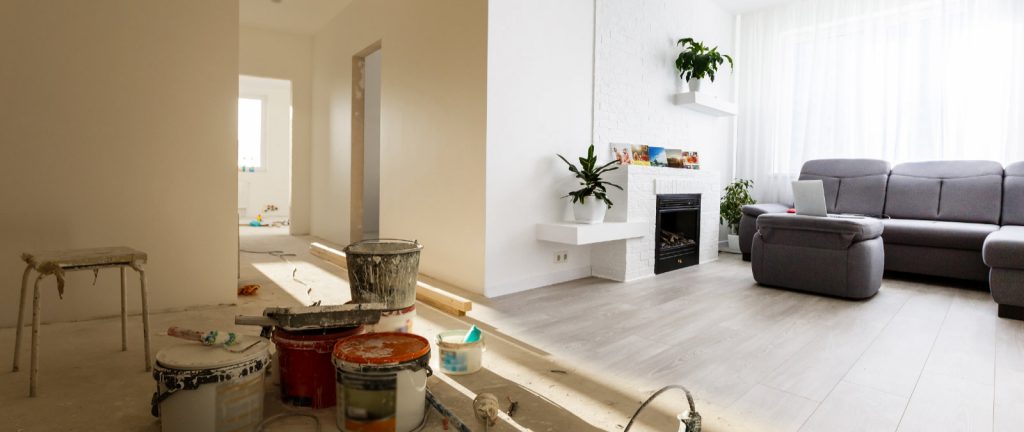Quick Summary
House Flipping and BRRRR (Buy, Rehab, Rent, Refinance, Repeat) investing are two popular real estate strategies that are actually very similar from a process perspective. Both strategies rely on the investor’s ability to identify run-down properties that have the potential to be transformed into highly valuable assets. The major difference is that with house flipping, the end goal is to sell the property, whereas with BRRRR investing, the end goal is to hold the property and generate rental income.
Key Similarity: Both strategies involve renovations that increase the market value of the property
Key Difference: With flipping, you sell the property, with BRRRR investing, you rent it out
Now that we have outlined the basics, it’s time to take a closer look at the advantages and disadvantages of each approach.
Pros & Cons of House Flipping
Primary Objective: Find a run-down house, renovate the property, sell for maximum profit
Pros of House Flipping
1. It can be a very fast way to build wealth
One of the biggest benefits of house flipping is the ability to scale. Unlike buy-and-hold properties which have a long term investment horizon, it is entirely possible to flip a house within 12 months of taking ownership. In fact, most experienced house flippers will aim to complete the project within 6-9 months, knowing full-well that every extra month they hold the property will eat into their overall profits.
In other words, the timelines involved in house flipping are directly opposite to most traditional investments that reward patience and long term planning. A direct result of this shortened investment timeline is that you can access your profits faster, and potentially start planning more flips. On this point, it is worth noting that experienced investors can flip multiple houses in a calendar year. You need only imagine multiplying your annual salary to get a better sense of how quickly you can build wealth with house flipping.
2. You can make more money with one flip than most people do in a year
The average annual salary in the United States is approximately $49,764. While this number is perfectly respectable, it is less than the average gross profit per house flip in the US, which is approximately $62,900. Naturally, this doesn’t account for the expenses that a house flipper will incur, but it does give you a good idea of how much revenue you can potentially make per flip. If you are able to flip a house on the side, you could dramatically increase your annual income. Alternatively, you could make enough money to start flipping houses full time.
3. It's a tried, trusted, and learnable process
Real estate is one of the most stable asset classes, and there will always be a pool of neglected homes that are in desperate need of a renovation. This means that there will always be a market for house flipping. It might become increasingly competitive, but the underlying opportunity will always be there.
Cons of House Flipping
1. You must have strong project management skills
Simply put, there are a lot of moving parts involved in a successful house flip. You need to secure funding quickly, complete high-quality renovations on a tight schedule, and stick to your pre-planned budget as best you can. To keep all these elements in place, you will need strong time management and project management skills.
2. If you fail to sell the house, it could fall into foreclosure
This is probably the biggest risk when flipping a house. If the market takes a turn for the worse and you are unable to sell the property, it could fall into foreclosure. If this does happen, you can lose the house, all the capital that you put into the down payment, and downgrade your credit history.
3. You can lose out on long term tax savings
There are a number of capital gains tax savings that you leverage if you hold a property for more than a year. However, most property flippers will aim to complete a fix and flip within 12 months. This usually means that you will forego the capital gains tax savings that you could access if you were to hold the property for a bit longer.
Investor Tip: To gain a more complete understanding of the costs, cash flow, and ROI that you expect with a house flip, this detailed hard money loan calculator can be very helpful. It provides an in-depth breakdown of net operating income for the full life cycle of the investment.
Pros and Cons of BRRRR Investing
Primary Objective: Find a run-down house, renovate the property, generate maximum rental income
Pros of BRRRR Investing
1. You get to keep all the properties you invest in
An obvious benefit of BRRRR investing is that you don’t actually have to sell the properties that you take ownership of. While house flipping is great for generating cash, with BRRRR investing, you forego the short term cash in favor of long term property appreciation. When combined with the cash flow that can stem from the rental income, it’s easy to understand why BRRRR investing can be so attractive to certain investors.
2. BRRRR properties can generate passive income for decades
While most investors chase the idea of passive income, it can be elusive at the best of times. However, with buy-and-hold real estate, it can become a reality, especially if you are able to build a portfolio with multiple rental properties. The beauty of this strategy is that the investment can improve over time. The rental income is likely to increase annually, while the amount owed on the bond decreases steadily. This should improve the cash flow of each property over time, meaning more money in your pocket without having to pay anything more.
3. It's a cost-effective way to implement the buy and hold real estate strategy:
BRRRR is different from traditional buy-and-hold investing because you aren’t focusing on turnkey properties that are ready for tenants. Instead, you are essentially purchasing discounted properties with lots of potential for improvement. When done correctly, you should spend significantly less on a BRRRR property than you would on a turnkey investment property.
Cons of BRRRR Investing
1. It’s time and energy-intensive
To complete a successful BRRRR project, you will need to invest plenty of hours into the process. Identifying a suitable property is time-consuming, renovations are time-consuming, finding tenants is time-consuming, and then you have to negotiate a refinance agreement with a forward-thinking loan provider. In other words, there are multiple phases in a BRRRR cycle, and each phase will consume time, mental energy, and financial resources.
2. You will experience periods without tenants
This is true of any buy-and-hold investment, and it applies to BRRRR investing as well. Simply put, every rental property has a built-in vacancy rate (the percentage of a given year that a property doesn’t have tenants). A 5% vacancy rate is pretty standard, but it could be higher or lower depending on the property and the area that you invest in. The main drawback is that during these periods, you will need to cover the financial obligations of the property until you can find a new tenant.
3. There are no guarantees that the property will be cash flow positive in the beginning
While the underlying aim of most buy-and-hold investors is to ensure the property is cash flow positive from the outset, it doesn’t always work out this way. In certain areas of California for instance, it is common for the monthly mortgage repayment to exceed the maximum rental amount that the market is willing to pay. To avoid this fate, you need to be extra diligent when researching properties initially. Searching for areas with a high average rent is a good place to start, but you will obviously to do significantly more research to pinpoint the perfect property.
Investor Tip: Although it sounds simple, each step of the BRRRR process requires mathematical analysis. Fortunately, this BRRRR Calculator can help guide you through the process, calculating how much you are likely to pay for each loan you take while deciphering the cash flow status of the deal.
How To Find Properties For Flipping & BRRRR Investing
There are a number of ways to find properties for flipping and BRRRR investing. These include attending bank auctions, finding foreclosures, searching online, and sending direct mail to property owners.
While all of these techniques can definitely work, you can also use FlipScout, which is basically a search engine for property flippers. You do need to create a profile in order to use FlipScout, but the platform is free at this moment in time. You can learn more about FlipScout here.
So Which Strategy Should You Choose
If you’re hoping to scale your wealth as quickly as possible: House flipping will be the better bet. Provided you are able to sell the properties for a profit, each flip can catapult your net worth. Better yet, as you gain more experience, you will be able to flip properties even faster, meaning even more wealth in less time. When executed correctly, you could generate life-changing income in less than a decade.
If you want to build a passive income machine: BRRRR investing is arguably the most cost-effective way to do so. You might not get the quick wins that house flipping can offer, but as your portfolio grows, you will be able to meet an exceedingly large portion of your living costs with the rental income from your investment properties. In the long run, you could end up with a passive income machine that can literally last a lifetime.



